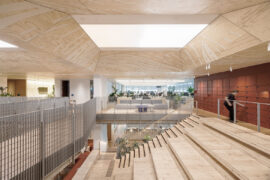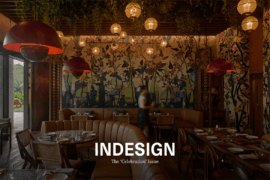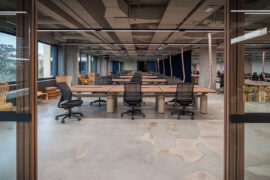With a focus on selective usage and natural regeneration, hardwood forests in the US are being managed sustainably. See how this combines with the knowledge of designers to make timber a sustainable and sophisticated choice.
November 17th, 2022
Wood is a material best understood through the dimension of time. Not only the time it takes for a forest to grow, and the history contained within one tree, but the lifetime of expertise developed by those who manage the forests and the designers who understand the value of quality material. Two fundamentals ensure successful timber design: a reliable and sustainable source of a supply and understanding of how to create with natural materials.
Sydney-based furniture designer Tom Fereday speaks of his work being “material-driven” and the importance of “celebrating the beauty of natural material.” Each piece has its own qualities so the task of the designer becomes one of working with the material rather than over-working it and exposing the character of the timber.
As AHEC regional director Roderick Wiles explains, as a natural material, wood has a huge amount of natural variation. However designers should not be daunted, as one of the roles of organisations such as AHEC, is to support designers in their understanding of the qualities and capabilities of different species, allowing them to work with confidence.
Perhaps most importantly, if selected with some understanding of source, designers can be certain that they are acting responsibly with regards to minimising the environmental impact of their design.
In the hardwood forests of the US, approximately three-quarters of the resource is owned by private individuals. Wiles describes how the owners “understand the value of the forest and want to look after it for future generations.”
They allow their trees to grow for longer and selectively harvest only a few trees per hectare. This practice promotes new growth through natural regeneration and this growth outstrips harvest. This means that the US forest is a resource that is increasing in volume every year. This is quite different from many forestry practices around the world.
With a combination of certainty of environmental impact and the vast range of quality species from which to choose, it is clear why American hardwoods are the go-to choice for a designer of Fereday’s calibre.
INDESIGN is on instagram
Follow @indesignlive
A searchable and comprehensive guide for specifying leading products and their suppliers
Keep up to date with the latest and greatest from our industry BFF's!

Gaggenau’s understated appliance fuses a carefully calibrated aesthetic of deliberate subtraction with an intuitive dynamism of culinary fluidity, unveiling a delightfully unrestricted spectrum of high-performing creativity.

Welcomed to the Australian design scene in 2024, Kokuyo is set to redefine collaboration, bringing its unique blend of colour and function to individuals and corporations, designed to be used Any Way!

Reuse, resourcefulness and material transformations bring unexpected stories to Arup’s new Brisbane office, designed by Hassell.

The second installment in our three-part series on collaborations between the world’s best designers and the American Hardwood Export Council
The internet never sleeps! Here's the stuff you might have missed

The latest print magazine is about to arrive! With Guest Editor Colin Seah of Ministry of Design (MOD), Singapore flooding our world with love, we are ready to party in style!

Architectus Principals Simone Oliver and Patricia Bondin are set to speak at WORKTECH Sydney this year, so we asked them for some sneaky early insights on workplace design.

The client’s brief was clear: create an environment that honoured FIN’s heritage while embracing its future. For Intermain, that meant rejecting the idea of the corporate, “boring” office and instead leaning into a space that would inspire, connect, and surprise.